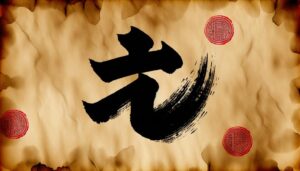What Does the Fish Symbol in Chinese Culture Represent?
The fish symbol in Chinese culture, rooted in ancient history, embodies profound meanings of prosperity, fertility, and good fortune. Its phonetic resemblance to the word for surplus makes it synonymous with abundance.
Used in folklore, art, and New Year traditions, the fish signifies bountiful harvests and successful ventures. Chinese art has historically depicted fish to convey harmony and resilience through different dynasties.
Culinary traditions also celebrate fish, particularly during the Lunar New Year, to invoke prosperity. Modern applications of the fish symbol extend to fashion, branding, and Feng Shui, illustrating its enduring significance and global influence.
To explore further, one can appreciate its nuanced roles across various cultural facets.
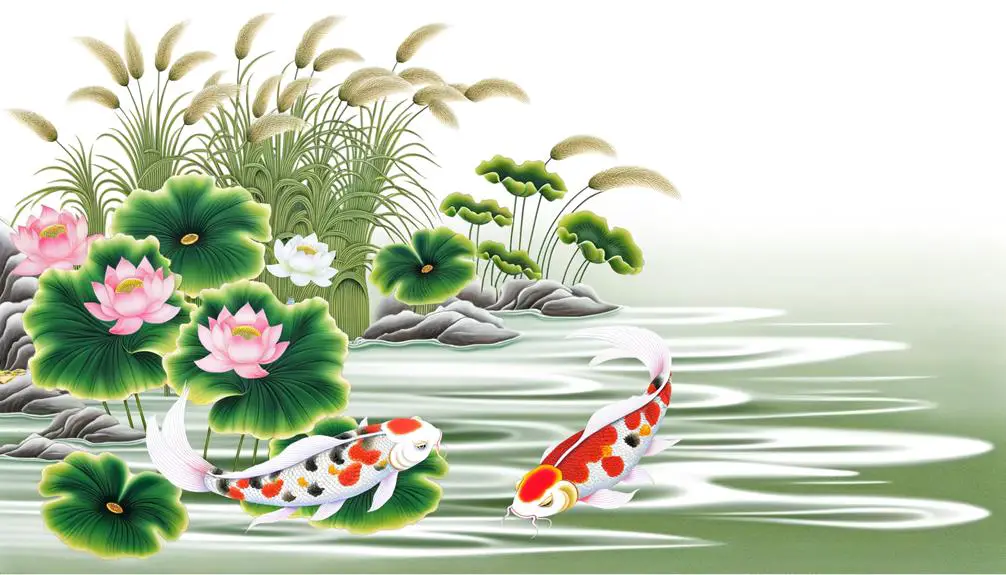
Key Takeaways
- The fish symbol in Chinese culture represents prosperity, fertility, and good fortune due to its phonetic similarity to the word for surplus.
- It has ancient origins, dating back to the Neolithic period and prominently featured in Han Dynasty tomb art.
- Fish are depicted in various artistic forms throughout Chinese history, symbolizing harmony, perseverance, and cultural values.
- During Chinese New Year, fish symbolize abundance and success, often featured in decorations and traditional greetings.
- Fish dishes are essential in festive meals, embodying abundance and prosperity, with specific types linked to luck and wealth.
Historical Origins
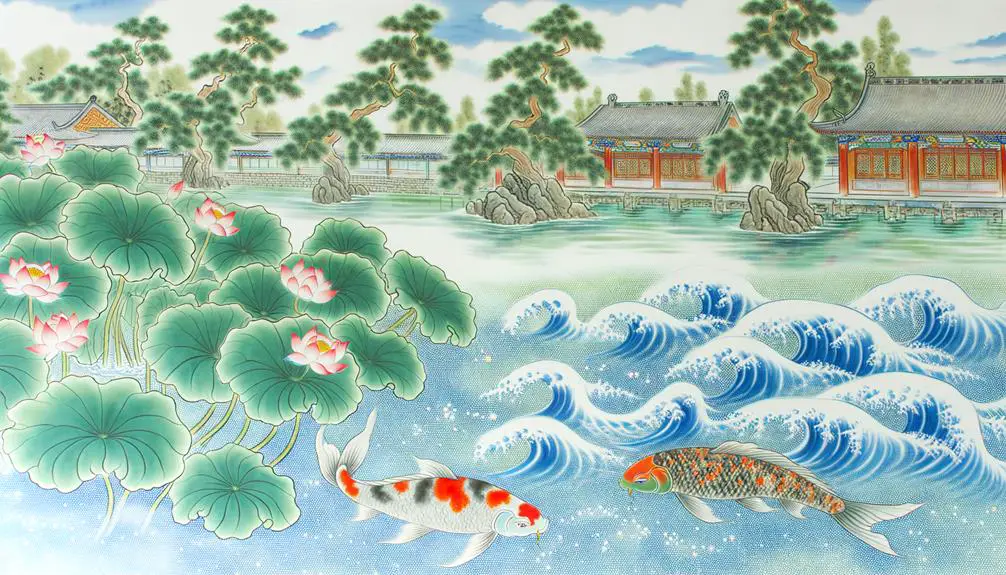
Historically, the fish symbol in Chinese culture can be traced back to ancient times, where it held significant meanings and was often depicted in various forms of art and literature. Archaeological findings reveal fish motifs on pottery and jade artifacts from the Neolithic period, indicating its longstanding cultural relevance.
During the Han Dynasty, the fish became a prominent decorative element in tomb art, symbolizing wealth and abundance. Literary references from classical texts such as 'The Book of Rites' (Liji) and 'The Classic of Poetry' (Shijing) further illustrate its importance.
The fish's depiction evolved, blending naturalistic and stylized forms, reflecting its integral role in Chinese cosmology and daily life. This historical context provides a foundation for understanding the fish's enduring presence in Chinese culture.
Symbolism in Folklore
In Chinese folklore, the fish symbol embodies a rich tapestry of meanings, often associated with prosperity, fertility, and good fortune. The word for fish, '鱼' (yú), is phonetically identical to the word for surplus or abundance, reinforcing its representation of wealth and affluence.
Folkloric tales often incorporate fish to signify bountiful harvests and successful ventures. Additionally, the image of two fish swimming together symbolizes marital harmony and prolific offspring, reflecting societal values around family and continuity.
Carvings and motifs of fish are frequently found in homes and temples, signifying a continuous wish for prosperity. This deep-rooted symbolism underscores the fish's integral role in cultural rituals and festivals, perpetuating its significance in the collective consciousness.
Fish in Art
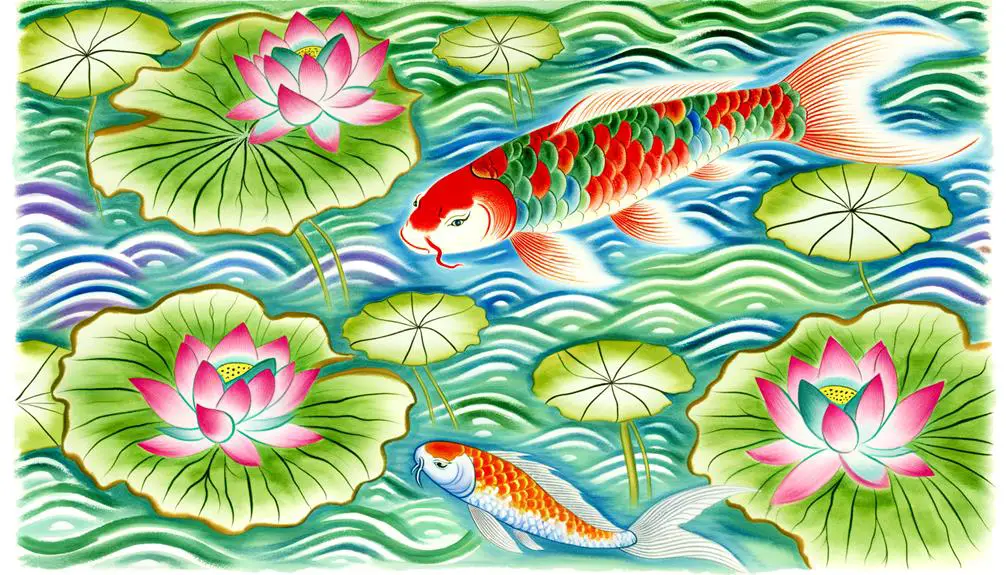
Artistic representations of fish in Chinese culture embody a confluence of aesthetic beauty and profound symbolism, reflecting the cultural values and philosophical ideals of different historical periods. From intricate brush strokes in traditional ink paintings to vivid depictions in modern art, fish motifs have been a staple in Chinese artistry. Through different eras, the symbolism of fish evolves, often representing prosperity, harmony, and perseverance.
| Period | Artistic Style | Symbolism |
|---|---|---|
| Tang Dynasty | Realistic, detailed ink paintings | Abundance, prosperity |
| Ming Dynasty | Porcelain with blue and white glaze | Wealth, good fortune |
| Contemporary | Mixed media, vibrant colors | Harmony, resilience |
Analyzing these art forms provides insights into how the cultural significance of fish adapts and endures.
New Year Traditions
Building on the rich artistic heritage, the symbolic presence of fish extends into New Year traditions, where it embodies wishes for abundance and success in the coming year. This cultural emblem is deeply ingrained in various practices and customs observed during the Chinese New Year, reflecting its importance in societal values and personal aspirations.
The fish symbol, often represented through decorations, rituals, and offerings, serves as a powerful metaphor for prosperity and growth.
- Decorative Art: Fish motifs are prominently featured in New Year decorations.
- Red Envelopes: Often adorned with fish images to symbolize good fortune.
- Traditional Greetings: Phrases like 'May you have surplus every year' incorporate fish symbolism.
- Ceremonial Practices: Fish are used in various rituals to invoke blessings.
Culinary Significance
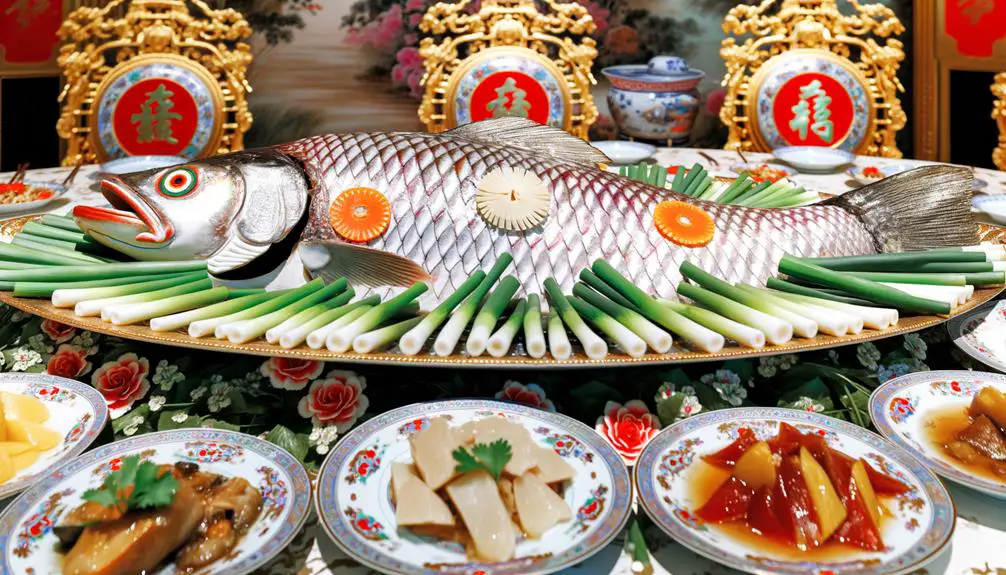
The culinary importance of fish in Chinese culture extends beyond mere sustenance, embodying a rich tapestry of tradition, symbolism, and communal values. Fish dishes are indispensable during important festivals, especially the Lunar New Year, where they symbolize abundance and prosperity. The word for fish, '鱼' (yú), phonetically mirrors the word for surplus, '余' (yú). This linguistic connection underpins the belief that serving fish guarantees a bountiful year.
| Fish Type | Symbolism | Occasion |
|---|---|---|
| Carp | Luck and Prosperity | Lunar New Year |
| Catfish | Wealth | Business Banquets |
| Crucian Carp | Good Fortune | Family Gatherings |
| Cod | Abundance | Weddings |
| Mandarin Fish | Harmony | Reunions |
The preparation and presentation of fish are imbued with cultural rituals, enhancing its significance in Chinese culinary practices.
Feng Shui Practices
How does the symbolic representation of fish integrate with Feng Shui practices to enhance the flow of positive energy in Chinese households and businesses?
In Feng Shui, fish are considered potent symbols of prosperity and abundance, often utilized to attract wealth and good fortune. Their fluid movement is believed to harmonize the flow of Chi, the essential life force, promoting a balanced and harmonious environment. Specifically, the placement of aquariums or fish motifs can invigorate spaces with dynamic energy.
- Aquariums: Positioned in wealth corners to amplify financial prosperity.
- Fish Paintings: Enhance tranquility and invite positive energy.
- Koi Fish: Symbolize perseverance and attract auspicious opportunities.
- Goldfish: Represent wealth and good luck due to their golden color.
This integration enriches living and workspaces with a balanced, thriving ambiance.
Zodiac Connections

The fish symbol in Chinese culture intricately interconnects with the zodiac, particularly with the Pisces sign, which embodies duality and fluidity.
Exploring the symbolism of fish within this context reveals deeper meanings related to adaptability, spirituality, and abundance.
Additionally, the compatibility of individuals associated with the Pisces sign and the fish symbol offers insights into harmonious relationships and personal growth.
Pisces Zodiac Sign
Pisces, represented by two fish swimming in opposite directions, embodies the duality and fluidity inherent in Chinese cultural symbolism. This zodiac sign, while rooted in Western astrology, shares intriguing parallels with Chinese beliefs, particularly in its representation of balance and interconnectedness.
The imagery of two fish suggests a harmonious coexistence of opposing forces, echoing the yin-yang philosophy.
- Duality: Reflects the balance between opposing elements.
- Fluidity: Signifies adaptability and change.
- Harmony: Resonates with the Chinese principle of living in balance.
- Interconnectedness: Highlights the relational aspect of human experiences.
Understanding Pisces through this lens enriches the appreciation of the fish symbol within Chinese culture, emphasizing its multifaceted significance.
Fish Symbolism Meaning
Exploring the broader implications of fish symbolism within zodiac connections, it becomes evident that the depiction of fish in both Eastern and Western traditions carries profound meanings linked to prosperity, fertility, and spiritual growth.
In Chinese culture, the fish is emblematic of wealth and abundance, frequently invoked during the Lunar New Year to attract good fortune.
The zodiac sign Pisces, represented by two fish swimming in opposite directions, symbolizes duality and the balance between the material and spiritual domains. This dual nature reflects the intricate interplay of yin and yang, reinforcing a holistic worldview.
Similarly, in Western astrology, Pisces signifies emotional depth and intuition, underscoring the transcendent qualities attributed to fish across various cultural paradigms.
Compatibility With Fish
Understanding the compatibility of Pisces with other zodiac signs requires an in-depth analysis of the interplay between their inherent emotional sensitivity and the distinct attributes of each sign. Pisces, symbolized by two fish swimming in opposite directions, often finds harmony or discord based on the elemental and temperamental dynamics of other zodiac entities. Their intuitive and empathetic nature can be both a blessing and a challenge in relationships.
- Taurus: Offers stability and grounding, complementing Pisces' emotional depth.
- Gemini: May struggle with Pisces' need for emotional connection due to Gemini's intellectual focus.
- Cancer: Shares a deep emotional bond, fostering mutual understanding and care.
- Sagittarius: Presents a dynamic contrast where Pisces' sensitivity may clash with Sagittarius' bluntness.
These interactions underscore the nuanced compatibility of Pisces within zodiacal frameworks.
Modern Representations
In contemporary Chinese culture, the fish symbol is frequently integrated into various forms of media, art, and design to convey prosperity and good fortune. This symbol appears in various modern contexts, from corporate logos to fashion. Its presence in digital media, including social media platforms, highlights its enduring appeal and adaptability. The table below offers insights into the contemporary applications of the fish symbol:
| Application | Description |
|---|---|
| Corporate Branding | Companies use the fish symbol to evoke success and wealth. |
| Fashion Design | Fashion designers incorporate fish motifs to signify elegance and affluence. |
| Digital Media | Social media platforms use fish emojis and graphics to denote good luck. |
These modern representations underscore the fish symbol's versatility and its continued relevance in conveying positive aspirations.
Global Influence

The fish symbol, deeply rooted in Chinese culture, has transcended its origins and now exerts a significant influence on various global cultures, art forms, and commercial practices. This symbol, often associated with prosperity and abundance, can be observed in diverse contexts worldwide.
- Fashion and Jewelry: Fish motifs appear in global fashion brands and luxury jewelry, signifying elegance and affluence.
- Culinary Arts: International cuisine incorporates fish symbols in presentation and branding, linking to notions of wealth and good fortune.
- Interior Design: Feng Shui principles, integrating fish imagery, are adopted in global home decor to attract positive energy.
- Festivals and Celebrations: Cultural festivals beyond Asia, such as the Lunar New Year, feature fish symbols, reflecting their positive connotations.
This widespread adoption underscores the symbol's universal appeal and versatility.
Conclusion
In summation, the fish symbol in Chinese culture has deep roots tracing back to ancient mythology and folklore. It functions as a multifaceted emblem of prosperity, abundance, and harmony. Its significance permeates various aspects of life, from art and cuisine to New Year rituals and Feng Shui practices.
Echoing the timeless wisdom of Laozi's Dao De Jing, the fish's enduring presence illustrates the intricate interplay between tradition and modernity, casting a wide net of influence both within and beyond Chinese society.


